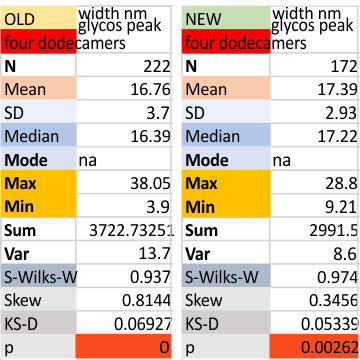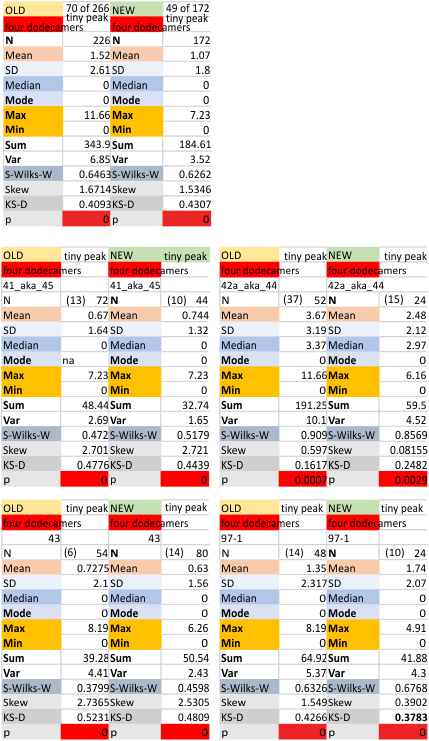Two different datasets (gathered with the same process, but just different plots) look so similar that it seems likely that this 16nm value for the width of the glycosylation peak will be appropriate for the training plots to examine the other 80 dodecamers of SP-D for which i have pictures.  The valus for all plots together (not divided into the four dodecamers) for old and new datasets below. Please note that the red box at the bottom is an indication of deviation from a normal distribution of the dataset, this shows a significant skew which appears because of the variations in the way signal processing programs divide up the plot into peaks, and how I arrange the peaks into a number (15) that was determined by those same image and signal processing algorithms.
The valus for all plots together (not divided into the four dodecamers) for old and new datasets below. Please note that the red box at the bottom is an indication of deviation from a normal distribution of the dataset, this shows a significant skew which appears because of the variations in the way signal processing programs divide up the plot into peaks, and how I arrange the peaks into a number (15) that was determined by those same image and signal processing algorithms.
Four Dodecamers: tiny peak (peak 2, lateral to the N termini junction peak) of SP-D
Here are additional, and hopefully the last, set of numbers for Peak 2 (tiny peak beside the N term peak) of SP-D, in terms of peak width. I have used all numbers, including those which do not detect the peak, generated by plots of the trimers (as part of a plot for a hexamer, one CRD to the other CRD to determine that particular peak width. I personally think that adding the missing values is a bit nuts but here are the data, including a new set of numbers which indicates that the peak is a non normal distribution.
It is fair to say that the peak width (when measured only on the values present (please note that the number of actual counted peaks is in parenthesis by N) is N=4, x=3.75+/ 0.34nm, which is consistent with measurements from the beginning of this study. For one dodecamer (42a_aka_44 see below on right hand side) this tiny peak was detected in more than half of the trimers plotted).
Four dodecamers of surfactant protein D, replicate tiny peak width (peak 2)
Four dodecamers of surfactant protein D, replicate tiny peak width (peak 2) which is a peak that shows up about 30% of the time. I have determined the peak width in nm in every which way i could, except combining the first (old) and second (new) datasets, which I chose not to do because there were some duplicates. The first dataset had every plot for every trimer that had been plotted up till that time. The second (new) dataset did not include the Gwyddion (red only in RGB) images, and so that left out all the limit range image filter images. The second dataset also did NOT include some of the far out filters in programs that were clearly not that usefor for determining structure. It is a select dataset that has a reasonable number of plots made mostly with images filtered with a gaussian blur, or median filter, and then peaks determined in 5 different signal processing programs (mentioned numerous times before, but including Octave (autofindpeaksplot, ipeak), Scipy, LagThresholdInfluence, and an excel template called PeakandValleyDetectionTemplate.
Note that the N termini junction appears twice (as there was no good way to divide the width of that peak in the trimers, as it represents a central combined value of a hexamer. Thus, a complete N term peak width is part of every trimer and appears as a complete peak each time. I am actually happy that the combined mean nm width for the tiny peak is about what I had hoped, that is, just around 3 nm. 30.1% is the occurrence from the first dataset 28% is the occurrence from the limited (second) dataset. The mean of 2.9nm +/ 1.8nm is a summar from data with missing values, without missing values, first and second datasets, and those two criteria applied to each of the four trial dodecamers (as trimers) individually. This works out to 16 separate tiny peak (peak 2) widths, for which the mean was found. Actual values are left hand column.
SEE NEXT entry for current numbers !!!
Pinterest trending: I hope not!
If this picture is any indication of what is trending in the US or anywhere in the world, then I believe the world is headed for a new low in “tattoo designs” “fingernail styles” “excessive ring wearing” ??? what is this? The tattoos are neither artistic nor particularly well done, and it looks like they are unimportant since they are covered with bracelets, the fingernail are honed to a point which means that someone is going to get hurt (hopefully not a child) and it shows how unlikely this person (trending) is going to be doing anything to maintain her upkeep, the bracelets are taken from the pull chain in the bathroom light, and the pose is with feet up on the sofa…. which has its own connotations. Sorry. This is not style. There is nothing beautiful, intellectual, graceful or thoughtful about the “trending on pinterest”. It speaks only to heubris and hedonism. How sad.
Four dodecamers of surfactant protein D, replicate N peak width
Four dodecamers of surfactant protein D, replicate N peak width.
Previoius values for the width of the center N termini junction of surfactant protein D dodecamers (from AFM images published by Arroyo et al), comprised a large dataset, hundreds of plots, four different dodecamers and the means for N termini peak width and all the other peaks (8 per trimer) were posted as well. In this new dataset, the Gwyddion processed images were not used because of the huge differences in grayscale values (Gwyddion exports as R, not RGB, and I assume that is the reason – at least I could not figure out how to export images processed in Gwyddion as RGB). Some plots were used in both datasets.
Also, the very far out image processing filters were eliminated, and the new set really is focused on 5 and 10 px gaussian blurs, very little else. ( i can make a list if someone would like it). Also, instead of hundreds of plots, there are many fewer, but very surprisingly the data from the big set of grayscale plots, and this abbreviated set are so close, that I think there is no reason to plot and process every image in all permutations and combinations of signal and image processing.
Comparisons are below…. listed as old and new, for the whole column – for the individual dodecamers (listed by name as 41_aka_45, 42a_aka_44, 43, and 97-1 — designations only for record keeping), and again, with an N of 4, using the N termini width for each dodecamer individually.
The n for the N termini peak width values duplicated…. a complete N width for each trimer, so the actual n is “half” that (see the (/2) notation on the excel images.
Wondering What Comes Next: music
Song to a poem.
Verge of a Dream: Reluctant Time
The barber pole
starts to slowly
spin.
Sky so dark
a fall downpour
has begun.
The owner staring
past the potted
plants, he’s
too weary
to arrange the comic
books.
Tapered comb,
in one chest pocket,
the scissor’s finger
rest, peaking from
the other. Seeing
through the drenched
window, black
witch, yellow moon,
school
kids painted for
Halloween.
Waiting for the
next crew cut
Its the watch
must
be that causes
time to have
become
so reluctant.
Pull open
the door to the
grammar school
in the morning.
And hear
the gray bell
warning of
the days’ beginning.
For you dwell
on hope the
girl in a plaid
dress is at your
group table.
And what was
learned today,
how once
recess and lunch
are over, is three
p.m. completes
a lasting trinity.
And eventually
a crooked
walk, before the
storefront Iglesias,
witnessing what
I do not. The
spring arrived,
the soft paper
pictures taken
from the walls
of the school
building hall.
Uncontemplated
in the dusty August
on the playground.
Romances and jousts
move
not an inch,
as they stall and
capture the flag
indifferent under
her eye
settling nothing for
the girl in plaid.
RLB 09-15-2022
Consistent approach to saving images used for image and signal processing in microscopy?
I wish I had known how much work I created for myself by using images from different programs, different ppi, different RGB, CMYK, grayscale, and dimensions. A little standardization in my approach would have made getting the data much easier. A word to the “wise”.
My images were from so many sources, so many were pixelated, low contrast, warped, screenshots from publications, and general inconsistent in quality, and made by different microscopes, and different microscopic techniques. A polyglot for sure.
Logitec
Wow, NASA can get signals and guide instruments from a billion miles away, but my Logitec wireless mouse can’t survive 4 months sending signals for 10 inches.
Verge of a Dream: Absorbed
And once the hours
Walking beside
The creek
Are complete,
I can read to you,
marquez
or dostoyevsky
In a fine light
I don’t care.
Then
can you read
to me
the little prince
in our winged chairs.
Stopping, not from
weariness or
boredom.
Except, better to
tend
the vines of
queen elizabeth,
tomorrow,
for needing
the quiet
rest of bed.
At another time
offering to
a mother,
a child,
the hope
someday, of
serenity’s nest.
And like you,
Saturday, the
night also’s
my
favorite as a
rain about us,
meaningful
and private
saying
we can be
absorbed
in safety, for all
danger is bowed
in place,
with schemes
confused until the
shielding rain
is done, unmindful,
in its soft
cleansing.
RLB 09-10-2022





